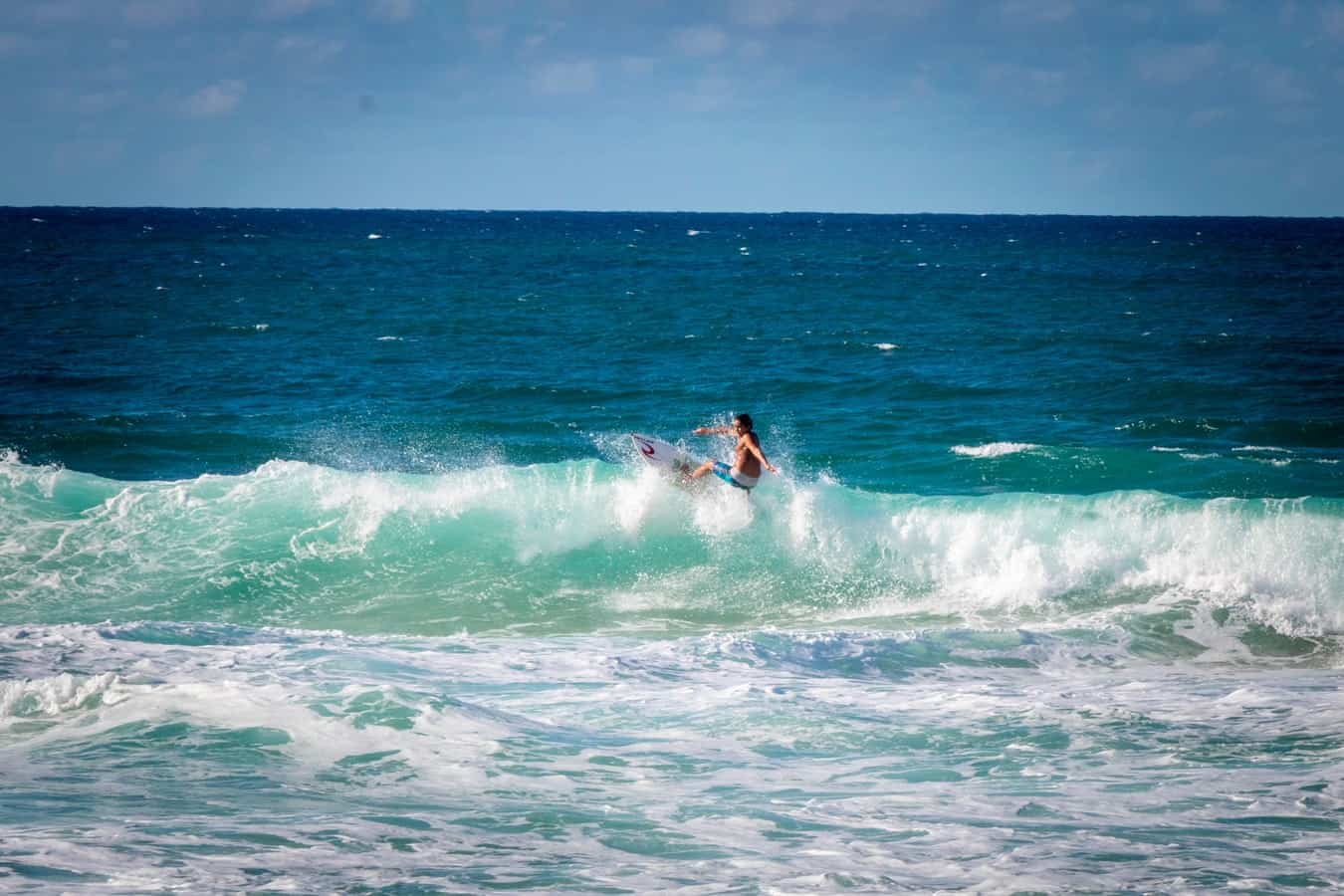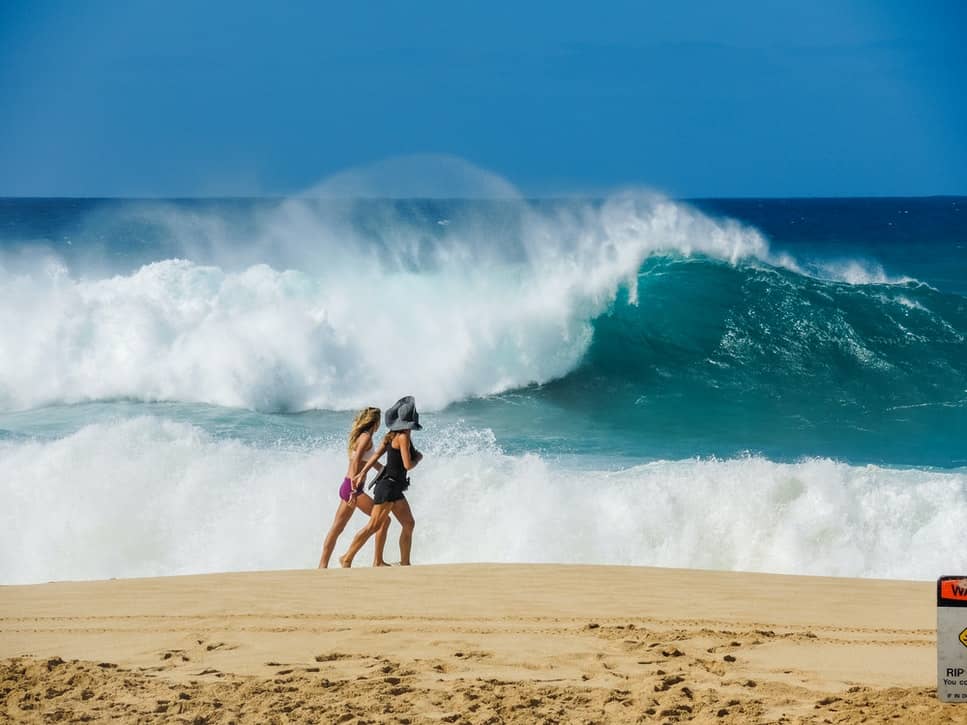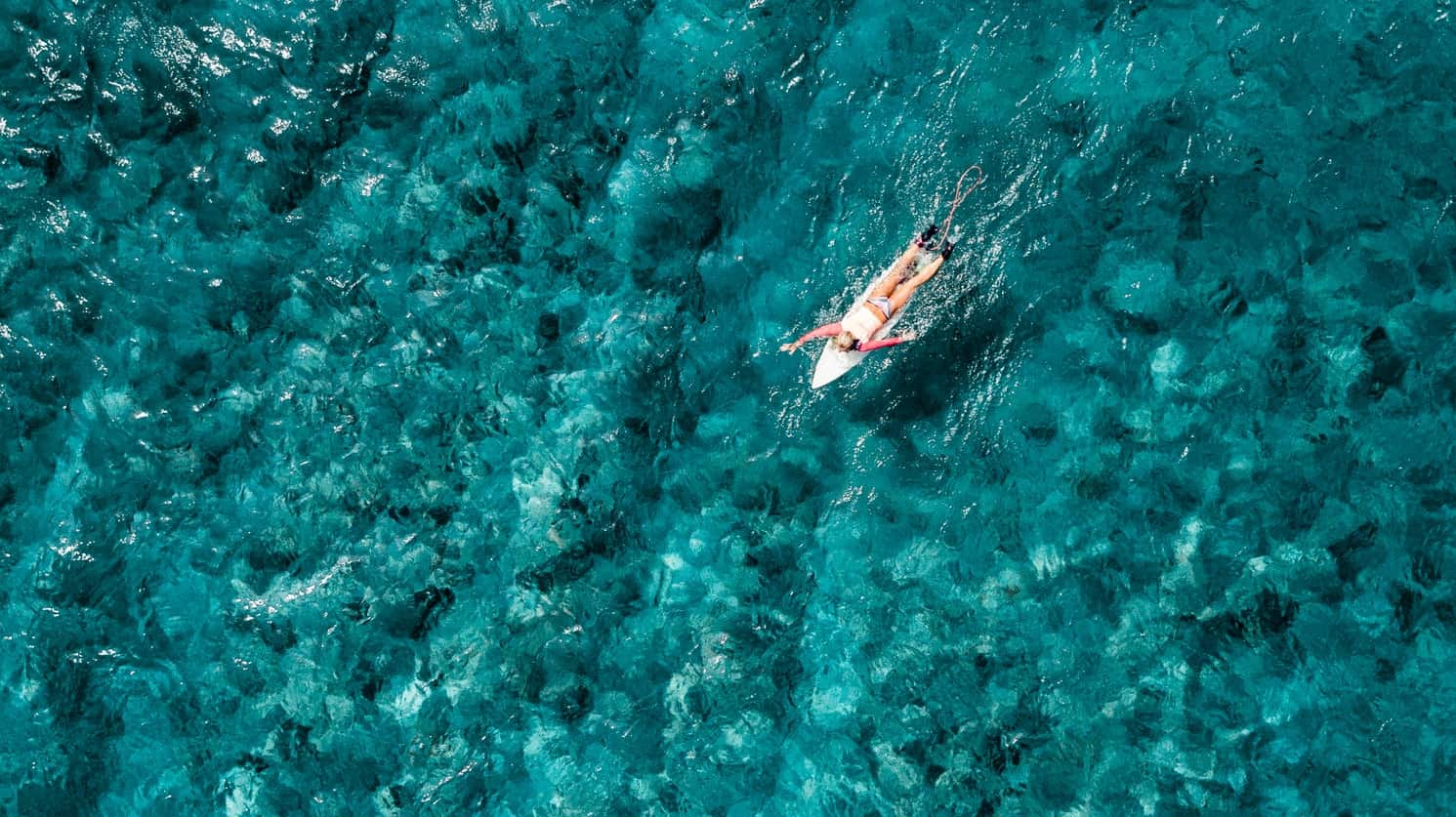Surfing is a challenge no matter how you look at it.
It’s a sport that involves agility, balance, and the whims of nature. Whether you’re a beginner or have been surfing for years, there’s always room to grow and improve your abilities.
In the spirit of growth, here are 35 tips to help you get better at surfing.
1. Take a Class
Taking a surf lesson should be the very first thing you do to get better at surfing. A surf instructor will be able to show you proper technique and form before getting out in the water.
Especially if you’re new, classes are the first step towards improving your surfing ability.
2. Get the Right Board for You Waves
Having the right board for the waves you’re riding is the difference between frustration and fun. Make sure the board you’re using fits the waves you’re riding.
If you’re typically in smaller surf, go for a longer board or one with more volume. This will aid you in catching waves so you can work on other skills.
If you ride bigger, curvier waves, go for a shorter board with more rocker. This type will help you fit the curve of the waves.

3. Get the Right Board for Your Skill Level
Choosing the right board is as much about the waves as your skill level. If you’re a beginner, go for a longer board with more volume. These have a lot more stability than other boards, perfect for learning.
If you’re an intermediate to advanced surfer, make sure your board is the right size and volume for you. Your board shouldn’t sink heavily under the water, this means your board is too small.
4. Video Yourself
One of the easiest ways to improve your skills is to actually see yourself surfing. Have a friend film you out on the water, either from shore or preferably with a go pro on the water with you.
Use the footage to critique and hone in your technique. It’s easier to improve when you can actually see from the outside what you’re doing.
5. Practice on Dry Land
Go through the motions on dry land before getting in the water. Move through paddling, your pop up and your stance. It may feel silly, but it will help your muscle memory when you’re actually catching waves.
6. Warm Up
Warming up may be one of the most skipped practices, but one of the most vital. Be sure to warm up your muscles before surfing.
It may seem unnecessary but it will improve your performance. When your muscles are stiff, you have less range of motion. It’ll make it harder to perform the moves necessary out on the water.
Not to mention the risk of injury. Spend at least five minutes, but preferably ten to fifteen, going through some light exercises to get your muscles going. You’ll be surprised at the difference it makes.
7. Ride the Right Part of the Wave
After you learn how to catch a wave, you have to learn to ride a wave. In the beginning, your goal is to ride perpendicular to the whitewash. This means straight out from the wave.
After you’ve mastered the whitewater, you can move on to more advanced riding. Once you’ve reached this point, aim closer to the pocket.
It will help you generate more speed for maneuvers. If you stick out to the shoulder, you’ll find you don’t have the speed to try anything interesting.
8. Learn to Generate Your Own Speed
Part of progressing is learning how to use your body to gain speed on the wave. Work on pumping your legs, using your arms and properly using your rails to get yourself moving faster. It may feel funky at first, but keep going.
9. Watch Other Surfers
Take the time before going out onto the water to watch other surfers. Pay attention to what they do.
How they paddle, where they catch the wave, how they ride and what their stance looks like. Mimic what the better surfers do and work to implement their tricks.
10. Strength Training
One of the biggest things you can do outside of the water to improve your surfing is strength training. Surfing may be a workout all on its own, but if you’re serious about improving, the addition of strength training will make a world of difference.
Try to stay away from only lifting heavy weights and working on superficial muscles. These can actually make you stiffer and won’t help as much. Be sure to mix it up.
11. Try Yoga and Pilates
Strength training isn’t the only workout to add to your routine. Yoga and pilates are great for building the smaller, stabilizing muscles of the body which helps with balance.
In addition, these workouts also help improve flexibility. Flexibility and increased range of motion will make a world of difference out on the water.
12. Visualize
It may sound silly, but picture yourself surfing with perfect form on the waves you want to ride. Visualization can help you find your weak points and keep working through them. Picture it before you do it.

13. Pay Attention to Your Head
Where your head goes, your body and board will follow. Keep your balance by keeping your head centered.
14. Pay Attention to Your Stance
How you’re standing makes a difference. When in your surf stance, keep the knees bent and your back straight.
This helps to absorb shock when trying new things on your board, as well as increasing your mobility.
15. Move Your Feet
This one goes along with your stance. Don’t let your feet stay static. Where your feet are placed on your board affects your speed, how you turn and change direction.
Place your feet more forward for speed. Place your foot back further for turns and changing directions. Play around with the best spots on your own board.
16. Watch Where You Catch Your Wave
Where you catch a wave is just as important as when you catch it. Aim for the peak when going after a wave.
The peak will help you gain the most speed for working on maneuvers. If you’re catching waves out to the shoulder, you’ll find the best you can do is just ride straight.
17. Power Paddle
Work on your paddle and pay attention to what your form looks like. Push your arms deep through the water with powerful strokes as you go after bigger waves.
This will help you go faster and help you match the speed of the wave more easily.
18. Learn to Use Your Rails
The rails on your board will help you generate speed and move through turns. Practice rail to rail surfing and get a feel for using your rails. This will help you advance to harder maneuvers and turns.
19. Surf With People Better Than You
Surround yourself with surfers that are more advanced than you. Like the saying goes, you are who you spend time with.
Spending time with more advanced surfers out on the water will help you push yourself and grow as a surfer, both by watching and the internal competition to work hard.
20. Ask Questions
This goes along with hanging around surfers that are better than you. Ask the surfers around you questions about getting better.
Ask them to watch you and give you critiques. Utilize the resources around you to improve.
21. Learn to Read the Waves
One of the key ways of improving your surfing ability is to learn how to read the waves. How are they peeling, right, left, or maybe it’s a closeout.
There’s many different types of waves and learning to see how they form and how to chase after different types is huge. Read about them and watch from the shore to practice.
22. Make Goals
We all need goals in life and surfing is no different. Choose a goal to work towards. Maybe it’s going after bigger waves, or learning how to turn.
It can even just be perfecting your stance. Believe it’s achievable and put your focus into making it a reality.
23. Get Used to Wiping Out and Wiping Out Well
If you’re ever going to improve as a surfer, you better get used to wiping out. While it may not be fun, it’s an inevitability.
The first, or even twentieth time you try a new maneuver, you’re likely to crash. It’s all part of the process.
The other part of the process is knowing how to crash without injuring yourself. Don’t dive head first, or even jump feet first off your board.
You never know how close the seafloor is and can end up hurting yourself. Instead, aim to fall flat. Not like a belly flop, but focus on having your body hit before your head and feet.
24. Let Go of Your Ego
Part of improving is setting your pride aside. You might look foolish sometimes, and that’s ok.
You don’t get better without trying new things, and that takes putting your ego and the desire to look cool on the back burner. Just remember, everyone starts somewhere.
25. Don’t Be Afraid
Fear can majorly hold you back when trying new things. Especially if you’re moving from whitewater waves to bigger and more powerful ones.
Going after bigger waves can be intimidating. The ocean is a powerful beast and the waves feel much bigger up close than they do on the shore. Push through any fear (within reason) and go after those goals you set.
26. Choose a Less Crowded Break
While it’s never a good idea to surf alone, you do want to choose a surf spot that isn’t crowded. If you’re spending all your time waiting in the lineup, you’ll never get a chance to really work on your technique.
You have to actually surf in order to improve your surfing. Check out different spots at different times and find the best one for you.

27. Look for the Sweet Spot When Paddling
When you’re lying on your board and paddling, there’s a right spot and wrong spot . Often times people are too far forward or too far back.
You want the nose of your board only about an inch out of the water. If it’s too high, your tail is under causing drag. If your nose is under, you’re set up for a nosedive. Like Golidlocks, look for the spot that’s just right.
28. Know Your Breaks
Different surf breaks produce different waves along with different challenges.
Beach breaks are seen as better for beginners but don’t always have the best waves for surfing. Reef breaks are known for consistent waves, but pose physical dangers.
Look into what kind of breaks are in your area and find ones best suited for your skill level.
29. Know the Surf Report and Learn How Waves are Formed
Reading the surf report is a habit of most surfers. Learn to read the surf report before going out. Different days will bring different waves, some better than others. In order to read and understand the surf report, you need a fairly good understanding of how waves are formed.
This will help you tell the difference between a crummy day and great day in terms of wind and swell. Reading the report before you go out will help you determine what kind of waves will be happening at your favorite spot and allow you to prepare accordingly.
Maybe you need a different board on different days.
30. Use a Wetsuit When Necessary
If you’re cold out in the water, you’ll end up stiff, miserable and headed back in after a short time. In order to improve, you need time out in the water.
Invest in a good wetsuit to keep you warm on the waves. It will make a huge difference in how long you can stay out for.
31. Don’t Underestimate Cardio
In addition to other training regimens outside of surfing, try to bring in some form of cardio. Surfing is an aerobic exercise, requiring good breathwork.
Take up jogging, use and elliptical, heck try a HIIT video. Anything that gets your heart rate up and can help improve your cardiovascular ability. The better your cardio, the easier surfing will be.
32. Focus
Make surfing a priority in your life. Focus on what you need to improve and do it. If becoming a better surfer is important to you, it will require focus and drive.
33. Surf Often and Practice Practice Practice
Never underestimate the power of practice. The more you go out the more chances you have to work on your skills and technique.
If you’re only headed out to surf once or twice a month, you’ll never see the improvement you’re looking for. Even once a week may not be enough in the beginning.
It takes time to build the right muscles necessary for surfing and time to build muscle memory. Just like when you were a kid playing sports, learning a new activity requires a lot of time. Go out as often as possible.
34. Stay Patient
Learning a new skill requires a huge amount of patience. Try your best to avoid getting frustrated or discouraged.
It may be impossible to avoid entirely, but don’t let yourself get down for too long. Patience is a virtue and you’ll need a lot of it if you really want to get better at surfing.
35. Have Fun
The most important and crucial tip, never forget to have fun. The whole point of surfing is that it’s fun. Why do it if it makes you miserable?
Work to enjoy the process. You won’t get better over night. It will take time, and like we said, patience. Have fun and work hard.
Related Questions
Where is the Best Place for Beginners to Learn?
If you’re a beginner, look for uncrowded surf spots with mellow waves. Typically beach breaks are suggested for beginners.
The sandy bottom and lack of rocks and reefs make them safer for newbies that may wipe out more often. Go for whitewater waves. In the beginning, your goal is practicing how to catch a wave and how to stand up.
Smaller, more gentle waves will give you the opportunity to practice the basics before heading out to larger more powerful waves.
How Do You Pick the Right Board?
Finding the perfect board can sometimes be a process of trial and error. The best option is to ask for recommendations, from other surfers and definitely from the employees of the shop where you’re purchasing your board.
Key things to look for are length and volume. Longer length equals greater stability. The newer you are to surfing, usually the longer board you need. Volume relates to how thick the board is. The thicker your board the better it floats.
As you advance, you may need less float in order to progress in turns and maneuvers. The other point is your height and weight.
The smaller you are, the easier it is to float. If you’re on the heavier or taller side, you may need more volume for the same buoyancy.
How Long Does It Take to Get Good at Surfing
How long it takes to improve your surfing depends on a number of things, but most importantly, how often you’re surfing.
If you head out everyday, you can probably get pretty good within several months. If you’re only going out once or twice a month, it will take a long time to see any improvement in your skills.
When your goal is to get better at surfing, the more you surf the better.

